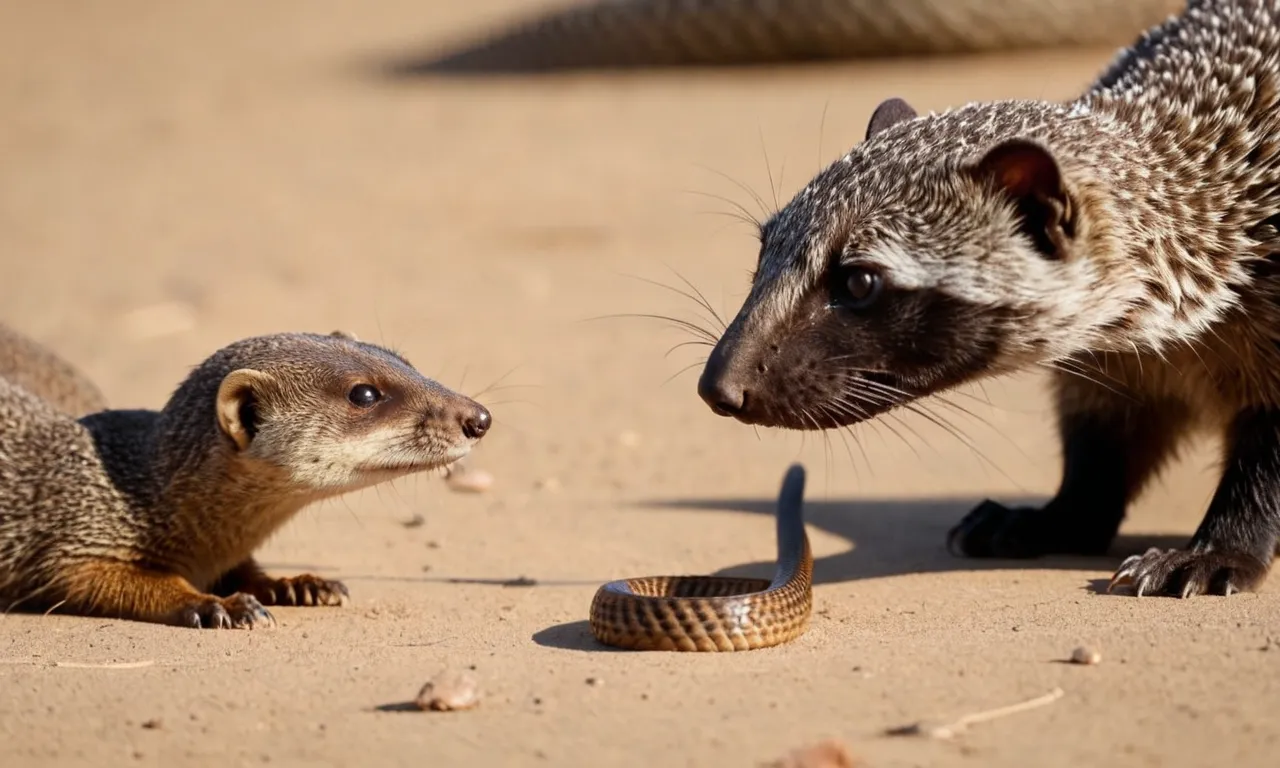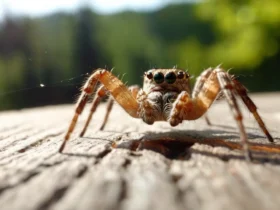Snakes inject venom when they bite to immobilize and digest prey. But some animals have evolved resistance and even immunity to certain snake venoms.
If you’re short on time, here’s a quick answer: Possums, hedgehogs, honey badgers, and mongoose are known to have some level of resistance or immunity to venom from snakes like cobras, rattlesnakes, and vipers.
In this nearly 3000 word guide, we’ll cover exactly how these animals developed defenses against snake venom over time, highlight scientific research about their immunity, look at differences between resistance and immunity, and more.
Mammals That Are Highly Resistant to Snake Venoms
Possums
Possums have a natural resistance to snake venom due to the presence of a unique protein called Lethal Toxin-Neutralizing Factor (LTNF) in their blood. Research has shown possums can survive lethal doses of venom from snakes such as eastern brown snakes, taipans, and tiger snakes.
Awesomely, when injected with venom, a possum’s body temperature does not drop, there is no swelling, and proteins and red blood cells remain unaffected. The LTNF binds to toxic snake proteins, rendering them harmless. Truly amazing!
Hedgehogs
Hedgehogs have immunity to most vipers’ venom due to the presence of a protein that inhibits the action of snake neurotoxins and myotoxins. Tests found hedgehogs survived injections of venom that would kill a human or other mammal the same size.
Researchers believe this ability evolved as defense against vipers trying to eat young hedgehogs. How cool is that?
Honey Badgers
The fearless honey badger has amazing resistance to venom from snakes, scorpions and bees. They can survive doses of venom that would kill many other animals. Researchers identified a protein called Ajidglyoxalase in their blood, which binds to and inhibits snake neurotoxins.
Their loose skin helps prevent venom absorption too. Plus, when bitten a honey badger will lick the wound to ingest antitoxins from its own saliva. Now that’s badass!
Mongoose
Studies found the Indian gray mongoose and others are highly resistant to cobra venom. Tests showed they survived injections with venom doses fatal for rabbits and guinea pigs. It seems mongooses have naturally occurring antitoxins and antivenene properties in their serum and red blood cells that neutralize snake venom.
A mongoose was even observed in a fierce 30 minute battle with a cobra, receiving several bites, but showing no ill effects!
How Mammals Evolved Defenses Against Snake Venom
Mutations in the Nicotinic Acetylcholine Receptor
Snake venom contains toxins that target nicotinic acetylcholine receptors (nAChRs) on the surface of muscle cells. This disrupts signaling between nerves and muscles, resulting in paralysis and death. However, some mammals have evolved mutations in their nAChRs that make them resistant to snake venom toxins.
For example, the mongoose has changes in nAChR subunits that prevent binding of snake neurotoxins. Other animals like honey badgers and hedgehogs also have nAChR mutations that confer venom resistance.
Serum Factors That Neutralize Venom
Many mammals have evolved serum factors that can bind to and neutralize snake venom toxins. For instance, the sera of Indian mongooses contains peptides and proteins that inhibit snake venom metalloproteases and phospholipase A2 enzymes. This helps protect their tissues from being digested by venom.
Similarly, hedgehog blood has small proteins called erins that directly bind and block the activity of snake venom toxins. Neutralizing serum factors have also been found in honey badgers, pigs, and dogs.
Rapid Cell Regeneration
Some venom-resistant mammals like opossums and hedgehogs can quickly regenerate damaged tissue caused by venom. Research shows they have rapid production of collagen and anti-inflammatory cytokines at bite sites. This minimizes tissue loss and promotes faster wound healing.
Their cells also upregulate protective heat shock proteins when exposed to venom, enhancing cellular resistance. Efficient regeneration allows vital tissues and organs to recover despite being initially damaged by venom.
Differences Between Resistance and Immunity
When it comes to protecting against snake venom, animals can either be resistant or immune. Though these two terms sound similar, there are some key differences between them:
Resistance
An animal is resistant to snake venom if the venom has less of an effect on them compared to other animals. Resistant animals can still be harmed by snake venom, just not as severely. Here are some key things to know about resistance:
- Resistant animals can still experience some toxic effects from venom, but they are milder effects.
- Their bodies can slow down the spread of venom, giving them more time to get treatment.
- They may have proteins in their blood that help neutralize some venom compounds.
Examples of venom resistant animals include honey badgers, pigs, and some breeds of dog.
Immunity
An animal is immune to snake venom if they experience no ill effects when bitten. Their bodies can fully neutralize the toxic venom compounds. Key immunity characteristics:
- Immune animals experience no tissue damage, paralysis, or other problems when bitten.
- Their immune system quickly clears venom from the body.
- They have special antibodies that bind to and neutralize venom toxins.
A notable venom immune animal is the opossum – tests show they can withstand venom doses from even the most poisonous snakes without harm.
| Resistant Animals | Immune Animals | |
|---|---|---|
| Impact of venom | Milder but still harmful effects | No effects, venom fully neutralized |
| How venom is processed | Spread of venom slowed, some compounds neutralized | Rapid clearance of venom, toxins fully neutralized |
| Examples | Honey badgers, pigs, some dogs | Opossums |
As you can see, there are important medical differences between resistance and immunity when it comes to snake venom and animal survival. Understanding these differences can help guide antivenom research and determine which defensive proteins or antibodies could have applications in human medicine.
Pretty awesome, if you ask me!
Snake Venom Composition and Variability
Snake venom is a complex cocktail of proteins, peptides, and enzymes that varies widely between species. Understanding the different components found in venom and how they differ is key to appreciating venoms’ incredible biochemical potency.
Neurotoxins
Neurotoxins are components that disrupt nerve impulses and cause paralysis. Snakes like cobras and coral snakes contain potent neurotoxins that can induce respiratory failure. These act on neuromuscular junctions, preventing acetylcholine from transmitting nerve signals.
Dendrotoxins are a type of neurotoxin that block potassium channels, overstimulating nerves. Fascinatingly, scientists have used snake neurotoxins as invaluable molecular tools in neuroscience research.
Hemotoxins
Hemotoxins damage red blood cells, blood vessels, tissues, and organs. Vipers like rattlesnakes possess tissue-destroying hemotoxins. These cause local hemorrhaging and necrosis at the bite site. Specific examples are snake venom metalloproteinases that digest proteins supporting blood vessel structure.
Some hemotoxins even prevent blood from clotting properly, leading to potentially fatal bleeding. Their mechanisms of action showcase the adept ways vipers rapidly immobilize prey.
Cardiotoxins
As the name suggests, cardiotoxins affect heart function, though not all venoms contain them. For instance, cobra venom harbors cardiotoxins that disrupt cell membranes and cause muscle tissue damage. These cytolytic peptides demolish heart muscle cells, inducing arrhythmia or cardiac arrest.
Interestingly, cardiotoxins were first discovered in cobra venom over a century ago in 1894. Their continuing study reveals intricate details about cell physiology.
Myotoxins
Myotoxins act specifically on skeletal muscle cells, destroying their structure and contractile ability. Sea snakes deploy myotoxic venoms that quickly paralyze fish prey. Terrestrial snakes can also possess myotoxins; for example, the venom of the African boomslang snake induces muscle necrosis.
Myotoxins like phospholipase A2 enzymatically degrade cell membrane phospholipids. Some myotoxins even enter muscle cells and cleave cytoskeletal components vital for muscle fiber integrity. Losing contractile function prevents prey escape and makes for easy dining!
Scientific Research on Venom Immunity
Researchers have made fascinating discoveries regarding animals that possess natural immunity to snake venom. Certain mammals, including some mongooses, honey badgers, hedgehogs, pigs, dogs, and opossums have evolved resistance over time.
Understanding the biological mechanisms behind this resistance could have important implications for developing antivenoms to treat snakebite in humans.
Molecular Adaptations
Studies have identified modifications at the molecular level that confer venom resistance. For instance, mongoose blood contains specialized neutralizing factors that bind to and inhibit snake venom toxins.
Researchers have isolated these factors and analyzed their structure – they are small proteins produced by mutations in specific genes over evolutionary timescales.
Other animals like hedgehogs have mutations in the AChR receptor – a key target site of snake neurotoxins. The altered receptor has 1000-10,000 times lower affinity for the toxins, preventing binding and protecting nerve cells.
Physiological Changes
In addition to molecular changes, some animals exhibit physiological adaptations that aid venom resistance. Mongooses have thick layer of tough skin and dense fur for protection. Fat layers may also act as physical barriers, slowing venom absorption.
Rapid wound healing has also been observed in honey badgers. Snakebites that would cause extensive tissue damage in humans seem to heal quickly in these animals, limiting the extent of injury.
Future Research Directions
While exciting progress has been made, much remains unknown regarding the intricacies of natural venom immunity. Areas for future investigation include:
- Comparing protective mechanisms across species to identify commonalities
- Exploring differences in vulnerability across ages within a species
- Examining the immunogenetics of resistance to uncover additional involved genes
- Investigating potential microbiome contributions to venom metabolism
Advancing this emerging field could someday enable revolutionary treatments that save human lives from the over 100,000 annual snakebite fatalities worldwide.
Conclusion
While no animal is immune to all snake venoms, possums, hedgehogs, honey badgers and mongoose have developed incredible resistance over time.
Through mutations, serum factors, and cell regeneration, they can withstand venom doses that would kill most mammals.
Understanding exactly how these animals overcome snake venom toxicity could someday help develop better anti-venoms to save human lives.








